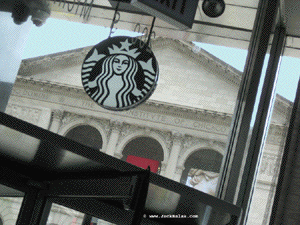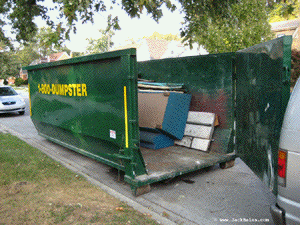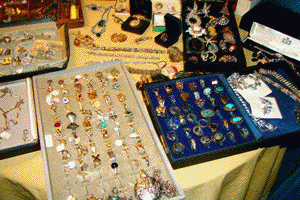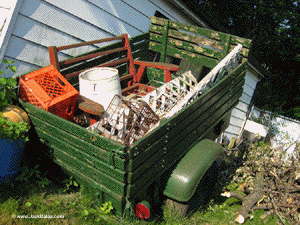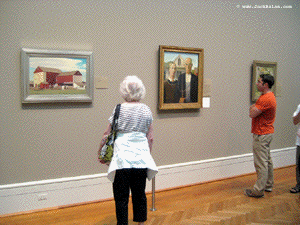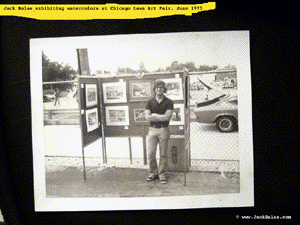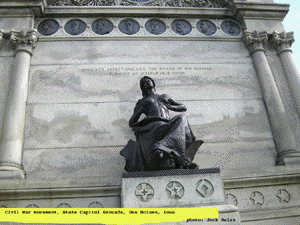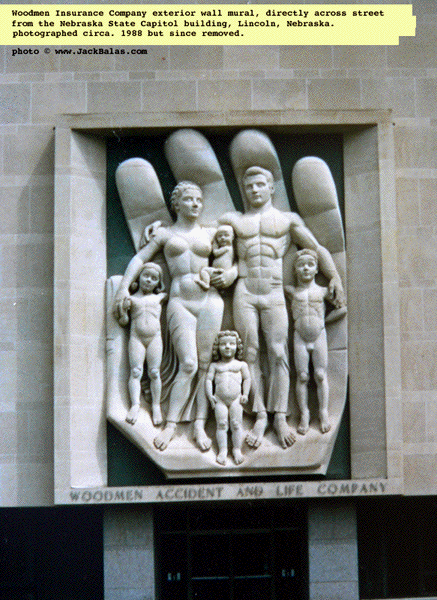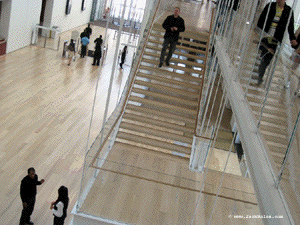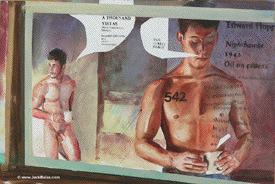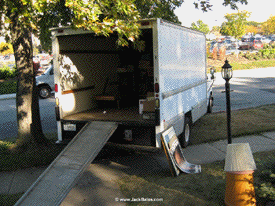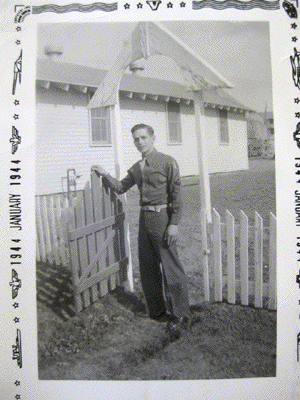
*
(October, 2009) (an intro of sorts...)
Sometimes what you say last is what you need to tell first, and
as it happened, the last talk I ever had with my father face-to-face
was in a Starbucks in Oak Lawn, suburban Chicago, on a blue,
crisp autumn day when I had flown in to see him on my way elsewhere,
a conversation in which we had wandered toward religion and the
idea of living up to one's potential. His religion was Catholicism
grown and anchored by the south side, but annealed in World War
II out of which he walked with only a bit of shrapnel in his
finger compliments of the Battle of the Bulge. He would always
say that he never knew why he was left standing, but he did know
that since he was, the one thing he loved (other than me and
Mom and my brother, and fishing -- the hierarchy is debatable)
was buying and selling things -- anything -- and so in the 60's
I would accompany him to Maxwell Street where we would browse
and dicker up and down the stalls of hubcaps and socket wrenches
and radiators and shoes and jewelry and hot dogs and tamales,
graduating in third grade to the wholesalers on Lake Street under
the El where he would stock up on rings and necklaces and battery-powered
fans to sell to colleagues at work on his lunch hour. Of course
those days are gone, but it's not without amazement that I visit
some of those same neighborhoods today to check in at my own
cathedrals, the minimalist white boxes where people come to browse
and dicker over the kinds of trinkets and baubles I myself make,
otherwise known as art. There is even a S-bucks down there too
now, where on a wintry blank Saturday such as the one after my
mother's funeral, you can, as I did with my steamed grande, gaze
into the steamed window as if it is some crystal laptop, trying
to conjure not only that past that has anchored me, but its intersection
as well with said art and the idea that the latter, in some oblique
way, can compensate for the loss of the former.
So anyway Dad and I are sitting in Oak Lawn and it's blue and
beautiful out the plate glass, and he is looking back not only
onto the last two years without Mom, but going way back, looking
over a life of 85, trying to make some sense of it, put it in
perspective if not quite explain it. This is difficult terrain
for him, even harder than Luxembourg and talking about that war,
at which times he always choked. But it did happen this day that
he reached that promontory and could look out, could tell me
that it had all been worth it, that he did have regrets, that
of course he would do it all again but that he would try to do
more that next time. And so the question was begging, and I asked
it. And in halting but not uncertain terms he wandered toward
telling me that, while he was pleased with my occasional success
as an artist, showing paintings in galleries and an occasional
museum, he thought it just as important that I continue to teach
as well, that doing the art by itself wasn't, in his opinion
and in the grand scheme of things, enough. Surprised, I started
to tell him that I wasn't much good at it, that in ten years
of teaching freshman comp. and studio art at various universities,
those departments and I had only tolerated each other. But he
knew where I was headed with that and he smiled, pointing out
the visiting gigs such as the one I was flying to that afternoon
for a couple of weeks, at a small university in the middle of
Ohio. "And anyway," he said, "it's the students
who really matter." As we were leaving, he shook his head
and added, "You, know, I never thought we could ever have
a conversation like this." I didn't think at the time that
I would ever be baking an essay quite like this -- something
that maybe we could have concocted all those years ago on Maxwell
Street -- an accounting, a receipt, blended with an equal amount
of memoir (but whose?), and with a shot of proselytizing whipped
in at the next stall for an extra kick. But anyway I suspect
that in writing it, it's really me I'm trying to teach something
to. So listen up, Jack, and let's get started.
* *

(nine months later, July 2010)
Two hawks are circling up in a blue hole, the rest of the sky
leaden on this humid dripping third of July as I watch, sweating
bullets, planes shoot from clouds on their approach into Midway,
arcing as lead will toward the earth. My parents' house is a
few blocks away and is a different sort of ark, also leaden but
with stuff, forty years of it in pairs and mixed sets, and I
have been here for several days sizing up people who do estate
sales. And stuff being on my mind, I picture the planes too as
arks, slowing to drop anchor from Europe into Ellis Island, depositing
grandparents as Polock and Slovak children a hundred years ago
and laden maybe not so much with stuff as with dreams of a new
life. I think of those trajectories as I look at the hawks, the
updraft they are riding, and imagine the two as Mom and Dad circling,
waiting in some holding pattern --not to land this time, but
to set a new course and sail.
* * *
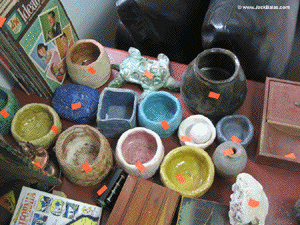
(September)
They are coming tomorrow, Mary Kay and Jim, a smiling young couple
from the Indiana suburbs, to start. Not that it didn't start
already three years ago when I first rented a dumpster, 30 yards
big and bright green, to help Dad begin to clean the house purchased
in 1970 -- not of usual accumulations of a lifetime as much as
the piles of hoarding that slowly took over, heaped into closets
and across furniture and barricading whole rooms making so much
unusable, inaccessible -- but back then both he and Mom were
still alive and the goal was simply to break the logjam, free
up enough space to allow him to bring in a hospital bed and her
back from the nursing home. Tomorrow, however, the goal is quite
different, and, like many adult children now in their 50's and
60's, I am looking at not only an estate sale and cleanout and
putting the house on the market, closing that chapter on its
life and theirs, but also acknowledging that this chapter of
my own is closing, soon to be unusable, inaccessible, turn the
page. Or is it?
I haven't lived here in 35 years, since 1975, but still it's been part of my life in all that time -- a 1958 three-bedroom brick bungalow "raised ranch" (a realtor will tell me) on a then-leafy street a few blocks from Chicago and six miles from the Back-of-the-Yards neighborhood where I grew up. A maple out front and another in back (the huge one), astroturf on the front stairs (black, Mom's idea), plaster walls (another realtor will tell me), a sunny south-facing bedroom where I spent three of my highschool years and the first two of college, a living room that never did get the floor-to-ceiling mirror tiles (also Mom's idea), a finished basement with a bar still stocked with 1970's Dad's Rootbeer in bottle 8-packs and quarts of Canadian Club Dad (my Dad, not of the root beer) would bring home every Christmas from work. There the black plastic music notes stuck on the walls can be seen poking (ironically?) into the photos Jim will post online Tuesday above the guts of the room splayed out across the tables they will haul in, above the cookware and punchbowls (3 kinds) and 8mm projectors and mildewed LP's and still-in-their-boxes coffeemakers ("premiums" banks used to hand out for opening new accounts, so we would go around and open two or four or eight regularly), the mounds of turquoise and purple and orange towels glowing under the "snow" encrusted colored lights set into the ceiling, each the epicenter of an old, now-warped 45 my brother would have bought, Penny Lane, One-Two-Three o'clock, Four o'clock Rock.
I punch up Google Maps, satellite view, and look down on rooftops and maples and late model Buicks and parking lots, seeing no one necessarily but knowing they are there, the people, the stories, if you step into the shadows or reach down to turn something over like the rings and watches Mary Kay is laying out in compartmental trays on one of the living room tables. This one Dad made, or rather he cut the stone, the turquoise, polished it on one of the grinders lurking in the basement behind the sagging pool table (the grinders it will take two men two hours to disassemble to get it all up the back stairs on Sunday; the pool table Jim and Mike will pulverize with a sledge hammer), set it into the sterling. Or at least I think he did all that to this one specifically. Hard to say when a man's hobby is the flea market, selling similar jewelry every weekend (all bagged and individually priced!) and men's watches and elastic elbow wraps and watches and rusty toasters and shag toilet seat covers and watches (did I mention watches?) (Jackie do you want a Rolex? thirty bucks!), heaped into the silver Ford Econoline along with the sawhorses and doors-as-tables cousin Dave and I slid into the garage in July onto the heaps of -- well, I should say the horn of -- plenty. Dad, where did you get all these hundreds of elastic magnetized wrist bracelets and ankle wraps and knee wraps? And this Sunbeam mixmaster, a twin of the twins already on basement shelves across from the washer and above the 20 gallons of bleach? (People buy the bleach the first hour of the first day of the sale, along with armloads of toilet paper and soap from what I've been calling the toiletries aisle.)
He started young, born 1924 and by 1929 or '30 or ' 32 was working for a dime a day, (an hour?) picking vegetables for a farmer on fields in this very neighborhood before Little Company of Mary Hospital was built, taking a streetcar over from Back-of-the-Yards and on the way home sneaking onto the golf course along Western to find errant balls he would then sell back to the country-clubbers. That was one of the stories, along with sharing a pair of rollerskates with a friend, when they'd each put on just one skate and go down the sidewalk together. That would have been back in Back-of-the-Yards, 51st and Damen, 47th and Ashland, in there where he and Mom were both born and where he, with 8 or 9 or 10 siblings (a few died before and during the War) would move around frequently, at least once a year, since Grandma would often move into a flat with only one or two kids and at night the rest would sneak in so as not to alarm the landlord, only to be evicted when said barbarian found out how big the family really was. It was all Slovaks and Polacks and Hungarians back then, making hrutka and holupki and kolachkys and many off the boat at Ellis Island, kiss the ground and never want to see Europe again.
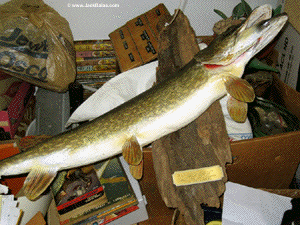
There is a world of difference between that 50th and Winchester, where I myself grew up (though I was born in a hospital a few miles away in Hyde Park), and 99th and Winchester, in Beverly, where I have parked the silver Ford Econoline that I have borrowed back from cousin Dave while I am here, parked now in order to catch the Metra, the commuter train, into LaSalle Street Station downtown. There are brick mansions here (or perhaps they should be called almost-mansions) with porticoes and pergolas and patios, almost swank, and I stroll down the slight hill to the station as if walking into a Sunday Morning postcard, a sleepy sequel to Edward Hopper's painting: the quaint closed 1940's storefronts, the warm September sun on ivied yellow brick walls and the three high school boys in St. Ignatius T's shoving each other playfully onto the tracks, eyed by 3 slightly older girls (probably McAuley or one of the other girls' schools). The train itself, when it does come sliding into this innocence, shoves me both back in time and further back (appropriate since it is a double-decker), to the early cross-country overnight rides out to Colorado to see Uncle Jim when I would spend some of those nights in the dome car looking out at the lights of barnyards and tiny towns of Iowa and we would stop in Omaha at midnight, pausing with an oiled humid hush of the brakes and the conductors passing silently through the aisles, or, closer to home, the times Aunt Mary would take me to the Loop to go to coin stores and ride the escalators at Carson Pirie Scott, riding the El above some of these same backyards, looking down, observing neighborhoods I have rarely seen in intervening years since I have almost always been over on the Ryan. So to cut through, on this train today, the I.I.T. campus, between 35th and 31st along State, is to slide, for me, through 1973 and 74 and 75 with an oiled hush, my architecture and design and fraternity days, two years trying to reconcile my interest, developed in high school, in painting -- looking out, observing, reporting, committing to paper (watercolor) -- with the notion of making a living.
He made a living, Dad, for awhile after the war (WWII, Army, Battle of the Bulge) doing construction, a steel worker walking beams going up on the Chicago Skyway and over the 70-foot span of St. Bernadette's, the parish church a block from this eventual Evergreen Park house where both he and Mom had their funerals from, and he drove a hot dog truck, a lunch route around to factories and offices on the south side, drove a laundry truck (all the towels that he took to the whorehouses! he would tell me), even a cigarette vending machine route, before he settled down with Eastern Express and later Blue Arrow and even later CW, trucking companies, local 710 of the Teamsters (a scholarship from which helped pay my way to those two years at I.I.T., and paid for nearly everything when I then transferred to Northern Illinois), dispatching trucks and inspecting freight on the docks. No evidence of all this going through the house today, however, (what souvenirs does one bring home from an office job?); mostly instead evidence of what he did in his time off: bowling trophies (Saints Cyril & Methodius High Game, 1964, 1966, thrown at J&B Lanes (no relation) where I and my brother also learned to bowl, just around our corner and above a furniture store across from Svoboda Drugs, where he was a pin spotter as a 13-year-old, reloading the pins in their template and swinging it back down to the hardwood before automation took over (and learning to duck whenever a strike hit)), fishing rods, reels, lures, tackle boxes, the lapidary equipment, the geodes, the flea market inventories. The biggest trophy is the 1955 Sears open-bed stake-wall trailer we pulled behind the car in 1960 when we were moving out to Denver so that he could open a branch of my Uncle Jim's fire extinguisher business, in that fall when John Kennedy was elected president and I wrote out the alphabet in my kindergarten and a classmate asked if that was my name. This trophy sells the first day of the sale, but it has been in the yard for years with no way out except through the drive-through garage, which momentarily (i.e for about the last 15 years) is piled with too much stuff to let anything more than a skinny guy pass; we have to wait for the sale to work its magic, reduce the inventory -- there goes the air compressor and Aunt Mary's glass-fronted scrollwork-doored bookcase, Mom's elaborately fendered 1940's bike and the hundreds of elastic elbow wraps (a bulk purchase)-- to the point where, on Sunday, Jim can make an aisle, a bit like Moses, to set it free to its new life as a work trailer for this guy with a landscaping/ handyman business, a beefy young dude in his early 20's whom I can picture, with only a bit of imagination, as Dad back then.
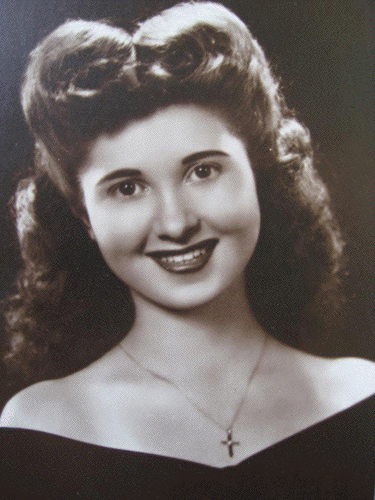
I can't picture Mom as Deanette, though, tall, spiked blonde hair, glasses. She's after vintage clothes and is one of Mary Kay's best customers; they let her in a few days early as everything is just getting started to be put out on the tables, and she's happy to rummage through piles and piles and boxes, even climbs the fold-down stairs into the bump-your-head-on-the-rafters attic, reeling a leopard-pattern skirt and turquoise brocade jacket and white-sequined clutch purse into her arms, much like Mom must have reeled in this stuffed fish Jim & Mike bring down from up there, a taxidermied Northern mounted now on a piece of driftwood above a small brass plaque commemorating the 1982 Canadian event. Did I ever in my life even see this? Maybe, though my brother Andy says he has not. I'll have to re-think you now, Mom, -- in these red and yellow plaid flannel shirts and the orange life vest to be seen not only in these Polaroids but still to be found here for real in the back bedroom, or tucked inside this yellow vinyl suitcase encrusted with 28 years of roofing paper grit sifted through the attic boards -- Mom, a fisher of Northerns with teeth bared who, on other days, after giving us haircuts and decorating Easter eggs and laying out cherry pies and scraping the potatoes off the kitchen ceiling when the pressure cooker lid was not clamped down as well as it could have been, will innocently gather together all of the flannel PJ's Andy and I ever wore as kids, the cowboy prints and candy-cane patterns and Woody Woodpeckers, stuff them into a box and mount the stairs into the attic-- the attic on Winchester, later transferred to the attic here in Evergreen -- so that one day your 55 year-old son can pull them out as trophies, look at actual colors (now faded) but always missing from the black-and-white snapshots with the borders stamped "Sept. 1959," "Dec. 1961" (from Svoboda Drugs), and plan to sew them into a quilt along with pieces of Dad's boxer shorts you also saved, the ones onto which you embroidered so long ago but in still-bright red thread, hearts and the word "Schmoie."
What does it mean to collect all this? To save it, gather it, take the time to put it in boxes and bags and piles and find room for it and when you run out of room keep on saving nevertheless? Do you save it all as a memory? Do you ever dig it out and look at it? Or do you want it so that you can forget it all? Do you discriminate? Do you have any sense of quality? Do these things say anything at all about you? About your times? Are they things you just happened to see at some other garage sale? Are they personal? Do you want others to someday consider them?
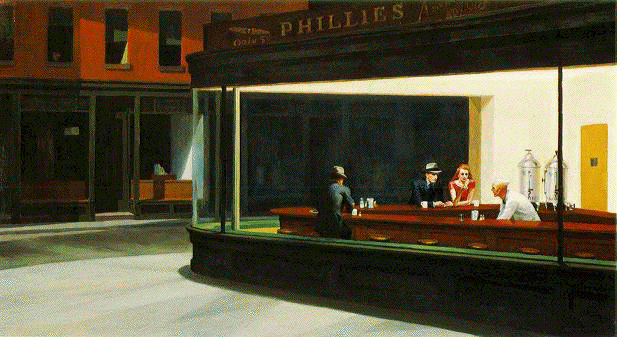
I ask myself questions like this as I wander the Art Institute at the end of the trainride today, and the Art Institute is elegant today, a refuge off of Michigan Avenue behind the stone lions (teeth bared?) that I have sought since highschool. The hushed galleries, the waxed floors, the oiled bronzes. The skylit central stairs ascending to The Collection, my then-cathedral, the Impressionists -- the Renoir woman with the red hat, the Caillebotte Paris street scene with the rain and big umbrellas, the Degas Spartan girls challenging the naked Spartan boys to a fight, the Monet Gare St. Lazare, the Van Gogh self-portrait that has yet to let me go. Here is Jules Breton's Song of the Lark with the woman listening in a field, the orange sun setting behind her (to me it has always been sunset). And not too far away the Edward Hopper Nighthawks, the Grant Wood American Gothic, and, off in the print and drawing room near the stairs, the box, an entire box! of Winslow Homer watercolors they would bring to you after you were seated at a table, open it, and walk away, leaving you and you alone to sift through, to marvel at and to dream, back then, vaguely, somehow, of becoming the artist, the observer, looking out, committing to paper and canvas this evidence not only of what you have seen but thought, and also, ultimately, of your very existence. People come here to look at this. They go out of their way, make special trips, vacations even to look at this, and they pay money to come through the doors.
Dad understood this. The summer we moved to Evergreen, 1970, I had just finished freshman year at Brother Rice. During that year, in addition to enduring the 8-mile ride on the CTA from Back-of-the-Yards, busses jammed cheek-by-jowl and cheek-by-armpit with a hundred other boys as we made our way slowly down Pulaski towards the school, I had discovered and joined the art club, learning to make coil pots with gaudy glazes, among other things, and endured the torture of one sophomore in particular, Paul, who enjoyed enacting big-brotherly choke holds on me (and could have been a lot more interesting if he'd been oiled and naked like one of Degas' young Spartans -- alas, I never went out for the wrestling team.) But that's where my own watercolors had begun, and when we moved to Evergreen only 2 miles from school I began to walk, freeing myself from busses, and I discovered the, to me, almost rural pleasures of looking at nature in neighborhoods where the houses were 15 feet apart or more, rather than the arms-stretched-touch-your-house-and-the-next-door-neighbor's-at-the-same-time gangway widths of Back-of-the-Yards. But it wasn't until after my sophomore year at Rice, and a summer of Dad's increasingly irritated suggestions to get a job (my response, in an obstinance learned from him, was that I was not costing him that much money), that I had amassed enough watercolors and enough casual courage to show them around to the faculty at school in a homemade corrugated-cardboard and masking-tape portfolio. And as soon as said faculty started to buy, at twenty and twenty-five dollars a pop, these images of covered bridges and ducks rising from misty lakes and lighthouses on rocky coasts, paintings inspired at first literally by the photos of calendar pages, he shut up, he never ever said a word to me again about money and getting a job.
Instead, he procured a pegboard for me, a six-foot-high, four-panel folding affair that went out to the dumpster three years ago, placed there, by me, with an affectionate smile. For a few years I did sidewalk artfairs, Evergreen Plaza at 95th & Western, the 63rd St. Fair, others, go and sit (and sell) your paintings for a weekend while the shoppers wandered past with toasters and coffeemakers and lug wrench sets. At the 1974 fair on 63rd St., Talman Savings (from whom we amassed numerous similar toasters and plaid blankets and cutlery, et al.) selected a dozen artworks from a dozen artists to reproduce in its next calendar, and so there I am (or, rather, there my painting is), a pin-up, the January 1975 page, a rowboat on a snowy blue beach with lighthouse up on a cliff, my first collection. (And, compliment of compliments, a few years later, I spot someone else's rendition of my painting at another fair; it's nowhere near as good.) A sort-of first exhibition soon followed, six or eight framed watercolors lined up in a row among the chalices and chausibles in the front plate-glass windows of St. Benet's Catholic bookstore & supply shop on Wabash Avenue downtown, right there under the El and the proverbial stone's throw from the Art Institute. (We went down to take photos of me in front of it all.) (Yes, of course I still have those photos.)
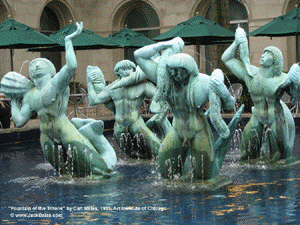
Dad had his own pin-ups, though he never hung them out in the garage above the workbench the way I've seen half the times I took the Granada or the G20 Van or the LeMans in somewhere for a brake job or new radiator; his were some Playboys and later a Penthouse or three I discovered once on Winchester with my brother, tucked into a dresser (along with bills and Army medals and a plastic vial containing the kidney stones that were, among others, one reason why Denver did not work out for us in 1960 and we returned to Chicago after only a month) and now which Mary Kay refuses to put in the sale, as they are "against (her) religion," though Jim pulls me aside the next day when I unearth another to advise that the only ones with any value these days are the classics like the Marilyn Monroe issue. What would Mary Kay (or Marilyn, for that matter) say about this classic 1931 "Fountain of the Tritons" by Carl Milles that I am enjoying today at the Art Institute, however, in the middle of the splashing water in the middle of McKinlock Court -- the four young and very naked mermen hoisting shells and fish above their shoulders like so many waiters' trays in this cafe where I have pulled up my chair to water's edge to sip my coffee and the view? Since high school I have looked out at these bronze bodies, smiling faces, enormous pecs and thighs and buttocks and would have been happy to oil them, not to mention make jokes about Polish sausage (but they are Swedes!) and hot buns rather than the grilled salmon over baby greens or braised lamb and new potatoes at the next table. These boys (whose hair, you have to admit, looks like some severe strain of combed linguine) have not aged a bit, nor has St. John the Baptist in the Wilderness upstairs (Velasquez or the school of -- it's being debated), a shirtless young man in the woods amid that gallery's seas of Reubens and writhing femininity. But no matter on which side of the fence you care to gaze, they were all made as symbols and still are, timeless reminders of ideas and ideals embodied into men and women who do not age but who are modeled after us at some point in our lives -- and we pay our money to come in here and see this and remember and be remembered.
I had been aware, however, of the double or triple standard at work here even back then, that there are tons more images of naked women floating around society at every turn, despite the fact that men and women roughly split the populace evenly, and everyone claims that's just fine for everybody, it's all perfectly normal, and if you happen to be a normal guy growing up in Chicago who happens to want to see guys naked in art you are going to have to endure life drawing classes where girls model eight times out of nine, and your macho Italian burly art historian professor, when discussing a Spinario (a naked boy pulling a thorn from his foot), mentions one's ability to look up between the boy's legs, laughing "that's so the gay guys can get their jollies." Maybe Lou should have been driving with me through Des Moines last July, when I was returning to Denver after spending those several days interviewing the estate sale-ers, and I stopped downtown there to look at the Victorian-era monuments up by the state Capitol. There, at the base of the marble column commemorating the too-many and too-young Civil War dead, a bronze woman, seated, points her bare breasts to the sky ("Iowa, Her Affections, Like the Rivers of Her Borders, Flow to an Inseparable Union.") Nearby, a monument to William Boyd Allson, a U.S. Senator ("Oldest in Senate, Wisest in Council, A Friend of All") depicts the suited octogenarian seated in a bronze plaque, but the plinth on which this plaque is anchored is topped by a marble woman, also seated, whose bare breasts point, like any Iowa windmill, a perky north. "An overwrought and at the same time thin veneer of metaphor painted over the tight collars of Victorian men seeking too to get their jollies," I can imagine Lou saying to me. But I prefer a much more moving sculpture two hundred miles west, in downtown Lincoln, Nebraska, and again across the street from the state capitol -- a limestone bas-relief of a larger-than-life 1930's or 40's family, in this case an outside wall decoration for an insurance company, wherein the man and woman, little boy and little girl, are all naked and fit into the palm of an enormous hand. Maybe if you look closely you eventually realize that the adults have very very thin clothes on, but regardless, one thing that's important is that this image is out there in very public view as you wander down the sidewalk with your state legislature thoughts, images of men (and women) who, as symbols, happen to be naked, telling you in a sense that you too can be a symbol, timeless. It's enough to make a guy feel normal.
The autumn leaves drift by the window, the autumn leaves of red and gold... I am kicking leaves through Grant Park as I hum this to myself, an old favorite I caught on the radio at lunch, as I make my way towards Buckingham Fountain. You learn a lot of old favorites if you, like your brother, take accordion lessons in Chicago in the 1960's from Ray Serva, a man who would come to the house once a week for an hour and, much like Lawrence Welk (whom I could hear on TV drifting through the bathroom walls Saturday nights as I had my bath) prompt you with an occasional Oom Pah Pah. Andy's accordion was disinterred the other day from under the now-dismembered pool table, its case about as green with mildew as the goose shit you are also kicking through here in the park, but the black and silver and ivory machine is still shining, still gleaming, and off it goes to some new life, its expiration date extended, pushed back, along with the outboard motor and Aunt Mary's piano (6 people, men and women, carry it out to a flatbed trailer), the orange living room lamps, my set of Bobbsey Twins books (the Hardy Boys I am keeping for myself), even a plate Mom made (she took up ceramics after my own interest at Rice, even bought a potter's wheel -- never used by her -- now in the back porch; I joke to myself that I am testing her market.)
Buckingham Fountain, however, is not going anywhere, a trademark of Chicago since the 20's and copied, verbatim, from the gardens of Versailles. These days there are snack restaurants positioned nearby, not to mention teams of new steel and glass punctuating the skyline from south to north like so many Bears and Bulls and Blackhawks loitering at the edges of their respective fields of play, crowding over the Prudential Building that once, with its observation deck on the 42nd floor, was the tallest building in the city. I wonder if I can go up there and still see 1964, not to mention the Michigan shoreline across the lake, as we did on our 4th-grade fieldtrip with Mrs. Kolpak which included lunch in a Chinatown restaurant. Even on this cloudy day in September Grant Park is a huge magnet, or more specifically its new quadrant Millennium Park is, with its stainless steel Bean by Anish Kapoor and its glass-tiled water-spouting video fountain by Jaume Plensa and the Ghery bandshell where the Chicago Symphony will play a free concert in a half-hour, all on land covering what was once a Grand Canyon of exposed and sunken railroad tracks separating the park from Michigan Avenue, across which all of this now gleams spotless and shining in the water glasses swimming across the stainless steel tables of new sidewalk cafes. The new Renzo Piano wing of contemporary art at the Art Institute has its own Grand Canyon lobbies with coffee bar and restaurant perched on a couple of rims, where you can gaze into the white skylit depths of the polished cathedral spaces (so elegant), noting Sunday flaneurs and art students alike, the latter doing their homework like I once did, noting names and title tags and dreaming, no doubt, of having their work here on the walls someday. And perhaps that's what's been bugging me since I got here, since I embarked on this stroll, once on the train at 99th St., down memory lane -- that my own work, my own paintings specifically, are not yet on the walls here, part of The Collection. They are, to be sure, parts of other museum collections, (and I feel my Dad nudging me right now, Jackie ya gotta blow your own horn, tell them which ones) but that's little comfort here on this home turf where, within these walls, I leafed through that box of Winslow Homer watercolors and began to dream.
Dreams can construct meaning and any meaning can be asserted by any artist of any object (or performance, or intervention) these contemporary days, and an audience will stop to perhaps read and consider, if not evaluate. One artist here has plunked down two expired jet engines into an elevated courtyard while claiming it is a metaphor for surveillance. I look at them and think more of deferred maintenance surrendering to failure, much like the van I just had towed out of my driveway and off to the scrap heap. The crowd coming in to the sale next Friday and Saturday (20 will be outside a half-hour early waiting to get in for first dibs) will look at the heaps inside with very different eyes than the ones with which I consider and remember; they will only see the objects and not care about the details (an approach some contemporary art would be better to acknowledge these days, i.e. to disavow no end of curatorial verbiage). Two women will leaf through stacks of LP's (Tom Jones What's New Pussycat, Eddie Blazonczek's Happy Time Polkas) and comment to each other "Boy she sure had a thing for Doris Day," and a man Dad's age will walk towards me outside shaking his head, "I'd need two lifetimes to gather that much stuff." To them I am just another shopper, not the heir-fils, so they can talk out loud the way people do when I am looking at one of my own gallery shows incognito. And yet I know very well the oiled, waxed hush one can induce by isolating any one of these various trinkets or tchotchkies or artifacts in the various transepts or apses of the Piano wing (or the Tadao Ando water-surrounded pavillions in Ft. Worth, or the Italianate piazzas of Richard Meyer's hilltop Getty, and on and on.) Stick all those LP covers up onto a wall in a grid, and people will come in and go OMG!! Put those H-O trains in a vitrine along with their concomitant ranch houses and shops from Plasticville (or, better yet, make the train burrow through the walls of The Project Space) and you then make a statement about dwindling resources in a locally shrinking but globally expanding economy. Take your rocking Howdy-Doody clink-clank pull toy, replicate it in stainless steel (or have it hewn from teak by Bavarian woodcarvers) and, like Jeff Koons and his stainless steel Bunny, you are on your way to a solo show in the Royal Apartments at the Palace of Versailles.
Like this art, the trains are elevated in Chicago (thus the name, the El), including, at La Salle St. Station, the commuter I am catching back to 99th St. And as I come down the hallway leading to the platforms, a busker is there, an older man playing a violin. When I am perhaps 80 feet away a woman my age goes up to him, asks him to play Autumn Leaves. He does it well, and with a flourish. I could not have been more elevated, having practically just run, with my own flourish, through the Art Institute in the last 25 minutes before closing, photographing the title tags of some of my favorite paintings. For the last four years or so, in one particular series of paintings, I have been making straightforward watercolor images of men I enjoy looking at, men on the order of those in the "Fountain of the Tritons," layering over them the texts and typeface and graphic design to be found in ads in art magazines. Part of my impetus has been to fancifully "see" my work in the magazines I read; but part of it is also meant to address that lopsided prevalence of images of women I mentioned, naked or otherwise, even in the insider and supposedly-liberal art magazines that offer little exception to this rule. So when I happened to take a photo of the title tag for Winslow Homer's "The Herring Net" instead of jotting it down in my notebook, that's when the lightbulb lit up: a new series of nudes, emblazoned with the artists and titles of works from The Collection: Thomas Cole (1801-1848) Distant View of Niagara Falls 1830;" "Mary Cassatt (1844-1926) After the Bullfight, 1873;" "Grant Wood (1891-1942) American Gothic, 1930;" "Ivan Albright (1897-1983) Into the World There Came a Soul Called Ida, 1929-30;" "Georgia O'Keeffe (1887-1986) Sky Above Clouds IV, 1965;" and more. Not a borrowing by any means, but rather an homage, a continuity and, most importantly, ownership. This is going to be, as ol' Blue-Eyes Frank Sinatra sings it, "My Kind of Town."
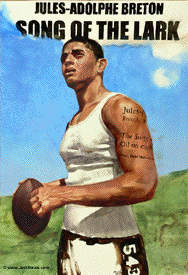 xxx
xxx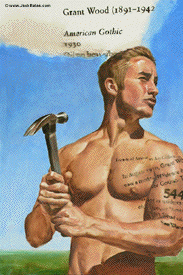
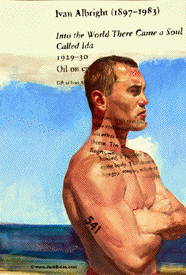 xxx
xxx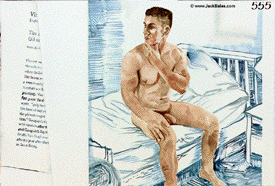
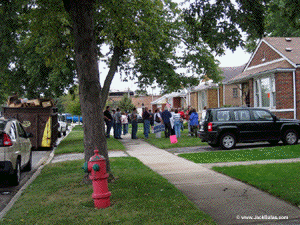
* * * *
Chicago is not exactly kind to our sale. It's a week later, Monday, and the issue is definitely still one of ownership. Despite four days of four people setting up for eight hours each day pulling boxes and positioning tables and displaying everything, and then two days of the sale itself, only about half of everything is gone, leaving still quite a bit. "Buyout" people are coming through now to have a look at the detritus, the picked-through piles, before offering me one price to take it all away. Two of them want me to pay them instead for the privilege, one saying he's basically going to cart everything to the dump and needs two weeks to do it. The others see the chance to take some of it off to antique shops and auctions and Ebay, and it's easy for me to pick the two-day offer that will pay me. But Brent is busy for the next week, so I fly home for some time off and to line up a truck I can rent with which to haul back to Colorado the pile of things from the house I have sequestered into my old bedroom for myself: old artworks and files and family photos, not to mention strange accumulations my Mom saved that can go into collage, such as a box full of envelopes from the mail, all empty and all with the stamps torn off from their corners. I need to think as well about the real estate options that have also come up: a choice to either sell in this 2010 depressed-economy-yet-to-hit-bottom housing market when leftover foreclosures have yet to hit the fan, or else to rent the house out, for a few years at least, until the market turns around. In either event I know the house needs some fixing up, even without the realtors I met singing three-part harmony about new paint, a dried basement, white trim rather than black (Mom's idea) on the back porch. But it's when one mentions new lighting, however, and after they all advocate tearing out the carpeting and sanding and finishing the (hidden) hardwood floors into a waxed hush, that another bulb lights up and I start to envision the house anew and something else altogether -- the clean, well-lit spaces, the simple white walls, the adjustable quartz spots, the young man in tasteful black (my idea) behind the info desk handing out brochures to The Collection -- namely, the John G. and Helen M. Balas Memorial Collection and Evergreen Park Satellite Project Space of the Art Institute of Chicago. I will want to tell them about it, and so after I load up that rented truck and begin my drive out west, I plan to stop to see them at the cemetery out near Joliet, the Abraham Lincoln National Cemetery where, in its green and waxy lushness they are buried in a double-decker grave (when Mom finally assented to Dad's heartfelt desire to be buried with his fellow war veterans, they began to joke about who's going to be on top?). I think they will like the new use for the house, its life extended, expiration date pushed back. And I may very well leave them with one and only one simple question: Hey you guys wanna buy a membership? Thirty bucks!
* * *
(October)
The cleanout has been surprisingly simple, four truckloads driven
to somewhere in Indiana (to be sorted through there) by Brent
and his two young helpers, one of whom in a beefy tanktop with
tatts curling out along his muscles here and there is very easy
to look at as they empty the house floor-to-ceiling, wall-to-wall.
But after setting aside the boxes and boxes of my own stuff that
I want to keep -- childhood drawings going back to day 1, report
cards and essays from grade school, term papers on Sinclair Lewis
and Mark Twain, religion handouts and notebooks of algebra and
calculus from high school, fraternity rush letters from I.I.T.
and newpapers containing awkward attempts at editorial cartoons,
and more of the same (but different) from Northern Illinois,
not to mention every design project, architecture plate (the
plan and elevation of the Pantheon in Paris), wood-laminate prototype
and dry-mounted photo and a bronze green pepper (a sculpture
assignment) and even more drawings and paintings and tubular
wood and found-object constructions -- after setting all this
aside, and then piling it into the Budget truck and walking through
the house with cousin Dave, spending two hours with him making
a list of all that needs to be done by way of new paint, carpet
removal, fix the basement wall crack and on and on, I find that
the one thing this has all been leading up to -- namely me walking
out the front door, closing it behind me and walking away --
is so very very hard to do. The rooms are absolutely empty, and
after 40 years the only evidence left of me or my brother or
Mom and Dad having ever lived here is me standing there, truck
keys in one hand and the doorknob in the other. Walk away, Jack,
just close the door and walk away. Dry your eyes; you don't need
this anchor anymore. And anyway those two hawks I saw back in
July, the ones circling, waiting -- I go out and look for them
in this bluest, crispest, October-est sunny day, but they are
nowhere to be seen.
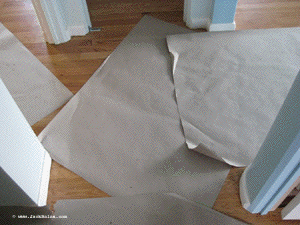
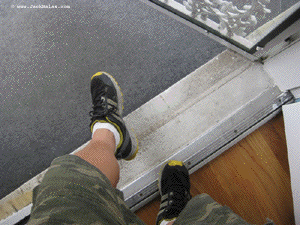
* *
(December)
For rent: 3 bdr. 1 ba. Evergreen house
hardwood floors, new paint, 2-car garage
screen & storm backporch, central air; walk to shopping
& Little Co. Mary hosp.; 95th St. bus lines.
1500 mo. +1st/last; lease.
Jack 9XX-XXX-XXXX landline
9XX-XXX-ZZZZ cell.
Out-of-state owner reserves right to use south-facing bdr.
on infrequent trips to Chicago.
*
Jack Balas
